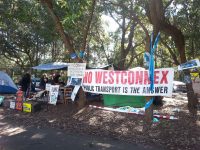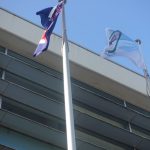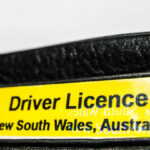Save Sydney Park from WestConnex: An Exclusive Interview with Anne Picot

Sydney Park is a huge green space in the heart of the city’s inner west. The 41.6 hectares of parkland provides a recreational space for thousands of locals who live in the surrounding urban sprawl.
However, the park is under threat. The Baird government’s WestConnex tollway project is set to acquire large strips of land along the edges of the park. This will make way for wider roads to deal with the influx of traffic the project will bring into the area.
Late last year, the state government announced it would be claiming an extra 6,000 square metres of parkland. This is in addition to an already reserved 8,000 square metres. And along with the land, around 350 trees will be lost.
Locals are also opposed to the St Peters Interchange that will be built adjacent to the park, as part of the $16.8 billion dollar project.
Described as a Los Angeles style “spaghetti junction of motorway ramps,” the interchange will cover an area of land the same size as Sydney Park.
The WestConnex protest camp
In an attempt to halt the project’s encroachment into the much loved park, protesters have set up a 24-hour-a-day camp at the Alexandria site.
Around 60 people have doing a rotation of stints at the protest, which started on Monday September 19.
The protest began as Sydney Motorway Corporation announced it would be starting preliminary work at the site, which would include the removal of trees along Euston Road.
Community support
Support from the wider community has been strong. Sydney Lord Mayor Clover Moore and NSW Greens MP Jenny Leong have both paid a visit to the camp and spoken out against the project.
Last Saturday, the community collective Reclaim the Streets organised a “protest-party” which saw a couple of thousand revellers turn up in support of the protest.
Ivan, a coordinator of the event, told Sydney Criminal Lawyers® that Reclaim the Street events bring together the local community, “giving them an opportunity to voice their opposition to various projects,” like WestConnex.
The police raid
However, the protest has faced opposition. The initial campsite was raided by police on its first night.
At around 3 am contractors began erecting a metal fence around the camp. Seven armed police moved into the protest site and dragged around five campers out of their tents, in what protesters described as a “planned and well-coordinated action.”
Anne Picot, a spokesperson for the WestConnex Action Group took some time out from the campsite to tell Sydney Criminal Lawyers® about what they’re fighting for.
What’s WestConnex going to do to Sydney Park?
WestConnex is actually taking great slabs of Sydney Park.
It has identified about 14,000 square metres down the end of Euston Road. So it’s the southeastern end, which is going to be part of a construction camp, while they build at the Alexandria landfill where the interchange is going to go.
They’re making on and off ramps in and out of the tunnels, which will then empty into Campbell Road and Euston Road.
So they’re widening Euston Road to seven lanes and all along the western side, so all of the trees along that side will go.
But what we hadn’t realised, is this wasn’t identified in the M5 environmental impact statement (EIS). The section of trees around the creek and up to the roundabout junction, weren’t identified for clearing.
On the first night of the protest police raided the camp. What actually happened?
The first night we camped, we were actually camped around the section of the main creek outlet, which is further south than the actual camp today. That’s the area that is now enclosed by the temporary barriers.
At three o’clock in the morning, even though the police had said they weren’t particularly concerned, they turned up to supervise WestConnex enclosing that area. The people were escorted out. I think there were a half dozen who were camping at the time.
And then the next day we were able to remove the tents and the other materials we had in there and relocate the camp further north, which is where it is now.
So that area, the lower area of the creek, has been enclosed ever since. But they’re not doing any work because they hadn’t actually provided an arborists report about the trees they wanted to clear.
They drafted one very quickly, which they forwarded to the Department of Planning, but the department didn’t approve it.
So that’s what’s happening with the enclosed lands.
There’s a bunch of other issues, not least of which, is that between the city council and Roads and Maritime Services, there’s an argument going on about where the boundary of Sydney Park is.
And Ausgrid, who’s supposed to be working on the site this week, is also extremely concerned because they have a very substantial cable which is actually built into the bridge over the creek and they’re quite concerned about what the heck WestConnex is going to do to it.
So there’s a bunch of issues at the moment, which are actually holding things up, while we are also there to try and stop them from coming into clear the trees.
What’s the significance of Sydney Park for locals?
It’s the premier open space, play space, green space and tree space in the area. It’s by far the largest park this side of Parramatta Road. It’s used by literally hundreds of people every day.
I walked back and forwards today between my place and the camp and there were literally hundreds of families, particularly small children, who were using the playgrounds, the cycling grounds, just enjoying the green space. The place was crawling with people.
Part of the WestConnex project is the St Peters Interchange. What is the interchange and how will that affect the local area?
The St Peters Interchange is where the new M5, which is duplicating the existing M5, comes out. There will be four exits and entryways coming out into this area. The area is the same size as Sydney Park. This means that the park will be surrounded on four sides by six lane and seven lane tollways.
The access to the park is going to be considerably more difficult in the future. Because it’s going to be this island surrounded by massive lanes.
Your protest is part of a wider protest against the WestConnex.
We are attempting to stop the whole of the St Peters Interchange from being built. We want to stop the M5 from being duplicated and we want to protect Sydney Park.
So what is WestConnex and why do you oppose it?
WestConnex is a massive road project – that was actually designed in 1947 for a completely different city – which they’re building as tollways in order to sell.
It’s a massive privatisation of the road system. If they actually complete it Sydney – that already has more tollways than any other city in Australia – will actually be one of the most tolled cities in the southern hemisphere.
Who’s behind WestConnex and why are they pushing for it?
The Baird government set its heart on building this section of the 1947 ring road, which was part of the County of Cumberland plan, which was promulgated in 1949.
But the critical thing about the County of Cumberland plan was that it actually surrounded most of the city – where the ring roads were supposed to go – with a green belt. But of course, we haven’t got the green belt.
And I don’t know why they’ve chosen to suddenly build this road because it’s not going to make one bit of difference to the traffic. What it will actually do, if they complete it, is deliver more traffic into areas which are already considerable traffic choke points.
Big business interests are behind this 34 km road project. Do you think the WestConnex protests are actually making an impact?
Well, we’ve managed to stop them for the last two weeks. And the only publicity that WestConnex gets these days – other than the Telegraph reprinting their press releases – is in fact pretty hostile because people are starting to work out not only are people losing their homes, their businesses and green space, but it’s actually going to make the traffic a hell of a lot worse.
And they’re going to be charged tolls. Anybody who’s actually going to try and travel the full length of it from the M7, it’s likely to actually run to about $120 a week.
So it is a really significant impulse, which is not actually going to solve any traffic problems.
If WestConnex isn’t the answer to Sydney’s congested traffic, what is?
Well the two things that really should be done for Sydney’s congested traffic, is first provide people with an alternative means of transport.
Now the critical thing they could do is actually improve the rail system and I don’t mean build a metro or light rail. I mean if they actually upgraded the signal system on the existing Sydney rail system, they could run a lot more trains on the tracks, which could move a hell of a lot more people for an awful lot cheaper.
The light rail proposals are a really good idea and the cost compared to the WestConnex tunnel system is extraordinary, because they could build 22 km of the light rail between Parramatta and Strathfield for about $2 billion and the cost of building tunnels with six lane highways going through them is about four times that.
The other thing they could do is look at traffic management.
But the critical thing is that Sydney is a sprawling city, so people cannot live near where they work. They could do two things about that. They could build affordable housing in areas where people work and they could actually move more jobs out to where people live.
And lastly, what’s the next step from here?
We will hang on here. But we’re also trying to chase down the conditions on a number of the things that they’ve proposed to do. Because at the moment one of the things that is really obvious – and it’s one of the reasons that planning is very concerned about this particular exercise by WestConnex – is that they’re not fulfilling the conditions of the original approval for the EIS and they are making a lot of mistakes which are causing a lot of grief.
Thanks very much for taking the time to speak with us today Anne. And we wish you ongoing success with your protest.
Thank you.







